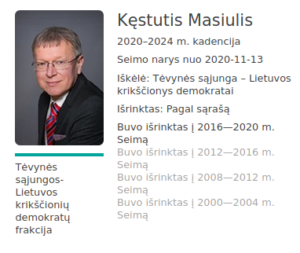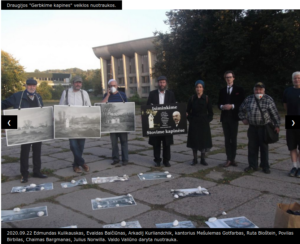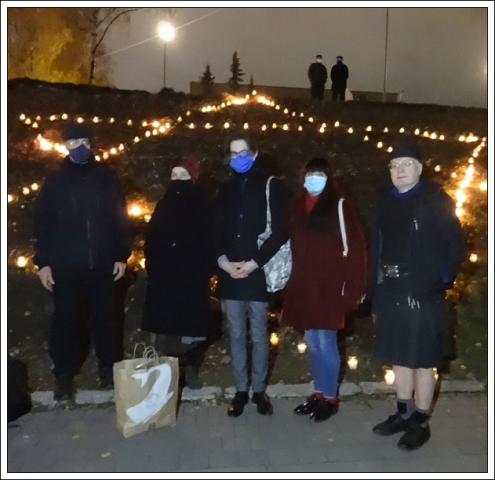OPINION | HUMAN RIGHTS | CHRISTIAN-JEWISH ISSUES | CEMETERIES & MASS GRAVES | OLD VILNA JEWISH CEMETERY AT PIRAMÓNT | OPPOSITION TO ‘CONVENTION CENTER IN THE CEMETERY’ PROJECT |INTERNATIONAL PETITION
◊
by Andrius Kulikauskas
◊
A Victory for Hanukkah, Christmas and New Year’s
On December 16, 2020, the sixth day of Hanukkah, defenders of the oldest Jewish cemetery in Vilnius (at Piramont-Šnipiškės) won a major, decisive, surprising, timeless victory. Lithuania’s government, acting on our campaign’s and Seimas member Kęstutis Masiulis’s proposals to the Seimas (parliament) Budget and Finance Committee, struck from the 2021 budget all funding for the reconstruction of the Vilnius Sports Palace into a Vilnius Congress Center. This building, which the Soviets had erected in the middle of the Cemetery, had fallen into disuse. The Lithuanian government acquired the building in 2015 with plans to remake it as a center for international conferences, further desecrating the Cemetery for untold years to come. Thankfully, the newly elected Government has eliminated funding.
The Government’s website includes a page for that afternoon’s meeting. The third item of the meeting is Finance Minister Gintarė Skaistė’s report on the revised budget. She spoke for twenty minutes and made no mention of the Congress Center. However, if you look through the documents (here and here), you will see that the allocation of 515,000 euros (around $631,000) as installment toward the multi-million euro reconstruction of the Sports Palace has been expressly eliminated.
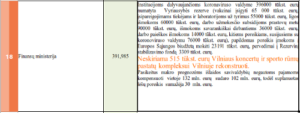
The highlighted sentence in the parliament’s revised budget explicitly eliminates the 515,000 euro allocation for phase 1 of the “convention center in the cemetery” project…
Seimas Budget and Finance Committee Bureau Chief Alina Brazdilienė sent me an email so that I would be sure to notice. She had been responsive to my concerns that the 54 letters and many more received by the Committee from us in November were not visible to the Government. On December 15th she had told me that the day before she had emailed the Ministry to ask if they would like to see our emails. The Ministry had replied that they would not because they had not yet come to their own position. Understandably, I was not happy that the Ministry was not interested to see all of our arguments. I did not expect us to win. I was wrong!
We have finally prevailed in a major battle in our campaign to defend our capital’s old Jewish Cemetery from further desecration. On December 17, 2020, Lithuania’s Parliament (Seimas) reviewed the revised budget, and will vote on it on Tuesday, December 22, 2020. It is inconceivable that there would be a successful motion to go against the new Government and restore funding to the Vilnius Congress Center. Thus in a few days Seimas will, in the absence of malevolence, pass a budget without the 515,000 euros which were intended for the public tender competitions for the Center’s operator and contractor.
The Government is thus granting the request by Seimas member Kęstutis Masiulis. He confirmed this evening that the Government has removed funding. For him personally, the building is a Soviet monstrosity. He cannot comprehend the nonsensical claims that its suspension roof is a cultural treasure which must be preserved. He will work in the future to assure that the building is never renovated and never used for any purpose whatsoever.
Of course we cannot let down our guard, not even during a pandemic-challenged winter holiday season. It may be that the original funding projections of sixteen million euros for 2022 and ten million euros for 2023 are still (or will be) penciled back in. And for the while being, the reconstruction is still on the list of “National Priority Projects.” Even so, Alina Brazdilienė agreed that defunding was a political decision by the new Government and that any plans for reconstruction are pushed back one full year and are, in principle, for now at least, — “politically dead.”
◊
A letter from the Chancellery
On the morning of December 16, 2020, just prior to the Government’s meeting, the Chancellory of the Government sent to our local group “Respect Cemeteries” (Gerbkime kapines) a copy of a decision which Prime Minister Ingrida Šimonytė sent to the Finance Ministry. Seimas member Antanas Guoga also received a copy, as did the primary proponent of the reconstruction, the state property developer Turto Bankas.
To the Finance Ministry
Delegated by the Prime Minister, we request that, in preparing and submitting the revised proposal for the Law Regarding the 2021 State Budget and Municipality Budget Financial Indicators, you analyze and evaluate the requests of the communities to not allocate funds to the Vilnius Congress Centre (previously Vilnius Concert and Sports Palace) reconstruction, and also to reply to the fellowship “Gerbkime kapines” (Respect Cemeteries) (sending also a copy to the Chancellery of the Government).
Government Chancellor Giedrė Balčytytė
The Chancellor appends a letter in Lithuanian from Ruta Bloshtein, Arkady Kurliandchik and Andrius Kulikauskas of Respect Cemeteries (Gerbkime kapines), much like the one in English which was sent by readers of Defending History, asking that the Ministry of Finance publish its analysis of the reasons received for and against financing, as well as its own arguments for its decision, and asking that it publicly recognize the widescale opposition, including our many letters, Ruta Bloshtein’s petition with its 53,000 signatures, the ruling of the Bnei Brak rabbinical court, and the recognition of Dovid Katz and our campaign by “The Algemeiner” in its list of Top 100 People Positively Influencing Jewish Life in 2020.
Next, the Chancellor appended a letter from Seimas member Antanas Guoga, and the letter he forwarded from Rabbi Elchonon Baron, Chairman of the International Committee to Save the Shnipishok Cemetery, and the spiritual leader of an array of international efforts to save the cemetery. Rabbi Baron, dean of a major Lithuanian tradition (Litvak) yeshiva in Jerusalem, and scion of a royalty grade Litvak rabbinic family, sent this important letter to most all of the members of Seimas.

Rabbi Elchonon Baron at Jerusalem’s Western Wall, expressing his dismay the week that Turto Bankas, the state owned property bank, triumphantly announced plans for a massive new annex for the planned convention center in the old Jewish Cemetery. Video here. In Jan. 2020 he led a delegation of Litvak rabbis who met with the Lithuanian ambassador to Israel (video here).
It was Antanas Guoga who made sure that this reached the Government. He is a longstanding critic of the Sports Palace reconstruction and associated corruption.
Rabbi Baron’s letter referenced opposition by world rabbinic leadership, including the Conference of European Rabbis (CER), Moetzes Gedolei HaTorah (Council of Torah Sages) and its parent body, Agudath Israel of America, the Orthodox Union (OU), NY Board of Rabbis, Central Rabbinical Congress of the USA and Canada, ten members of the Israeli Knesset, the Chief Rabbi of Israel, Israeli Minister of the Interior, Bnei Brak Rabbinical Court of Rabbi Nissim Karelitz, Chief Rabbi of South Africa, among others. I think it was a collective PDF of a selection of letters that the Prime Minister had in mind in referring to the arguments of the “communities”. This was convenient for all because at this hectic time the Finance Ministry could take them as representative of the many letters that we all sent to Seimas and the Government. I also infer that the basis for the Government’s decision is primarily religious and political, and not economic. The Finance Ministry will write us and we will know.
Letter writers and storytellers
Credit for our victory this month goes to the more than one hundred people in Lithuania and around the world who defended the Cemetery by writing letters to the Seimas Budget and Finance Committee, the Seimas leadership, and the Government. Here is a fine representative example by Rabbi Pinchos Hecht. Special thanks to Julius Norwilla whose article on October 30 in Defending History inspired the initiation of our letter writing campaign.
Our letters echoed voices heard in Lithuania and around the world. Especially timely, on December 13, was the extensively researched hour long report by national public broadcaster LRT Radio’s journalist Vita Ličytė in which she interviewed Chaya Fried, Itzik Pines, Rabbi Elchonon Baron, and me, as well as our opponents, including Turto Bankas General Director Mindaugas Sinkevičius and Vilnius City Master Architect’s Senior Advisor Rūta Matonienė. Mindaugas Sinkevičius explained that Turto Bankas was directed by the Lithuanian government to work specifically with the rabbis from the Committee for the Preservation of Jewish Cemeteries in Europe, and it simply “was not our problem” if these rabbis were subject to rulings by the Conference of European Rabbis or the Bnei Brak Rabbinical Court. Journalist Arvydas Jockus recorded similar comments from Lithuania Jewish Community Chairwoman Faina Kukliansky that she need not be a religious practitioner, they were not a religious organization and the Court had no jurisdiction. This illustrates the maxim that international pressure can be ignored if not for the investigation and exposure by local media and also the advice of local activists who can direct where and how to apply pressure.
Independent journalist Skirmantas Malinauskas published an hour long video expose of dramatic cost overruns with the technical project totaling 64 million euros. He reached 82,000 viewers who left 383 comments about fighting corruption. Yet we have no knowledge of any of them joining our efforts. As far as I can attest, our victory resulted from a smaller group of people, although every voice matters, such as the article by Povilas Sigitas Krivickas.
The story of the spirit
In 2015, as the Government purchased the property, Dovid Katz began to publish a series of articles in Defending History which turned from concern to alarm once he saw on the Vilnius evening news in mid April that year the deeply disturbing scene of some very non-Litvak Hasidic rabbis from London celebrating a “deal” with the then prime minister of Lithuania to turn the site into a national convention center with a brand new annex (see the series, esp. from 29 April 2015 onward; his own op-ed came out in The Times of Israel). Over the months that followed, he inspired Dov-Ber Fried whose activism started with an August 2015 article in DH. Mr. Fried’s wife Chaya rose to the occasion to become a major international organizer. Dovid and Dov-Ber, friends for many years, had previously partnered in helping poor, religious, lonely, elderly Jews in Lithuania, and particularly the late Berel Glazer. Dovid recruited many others, including me. See now the first articles on this by Ruta Bloshtein (who went on to launch the international petition), Julius Norwilla (who would go on to set up a committee which produced an array of famous visuals and cartoons), and myself; I was the first to bring the cause to mainstream Lithuanian media in Jan. 2016, asking my countrymen what it is they want their grandchildren to see looking down from the Hill of Gediminas: the magnificent Jewish cemetery that the Grand Dukes saw, or the Soviet monstrosity that the commissars looked out at?
At Dovid’s urging, I tried to get help from the Catholic Church, but achieved absolutely nothing. As a philosopher of life, I note what works and fails in order to develop a science of miracles, of God’s intervention, of prayer, of spirit, of life and love. Let’s learn to make miracles easy!
Authentic Lithuanian and Litvak unity
At the end of 2019, my father Edmundas Kulikauskas prodded me to let go of my skepticism and make the most of the coming Year of the Vilna Gaon (2020). The Foreign Ministry committed to a social media campaign #VieningaLietuva whichmeans United Lithuania. But it never followed through, perhaps because I acquired the related domain VieningaLietuva.com. We met regularly at Agata’s Freunde restaurant in Vilnius as seven or eight Lithuanians and Litvaks learning to talk about the four painful issues that Lithuania has neglected: the promotion as national heroes of various Lithuanian leaders who committed mass crimes against Jews, the disparaging of Jewish partisans as Soviet collaborators, the local demonization of our beloved Dovid Katz, and the envisaged desecration of the Jewish cemetery at Piramont.
On December 13, 2019, the cultural newspaper 7 meno dienos was obliged to publish a letter by Lithuanian Jewish Community Chair Faina Kukliansky where she introduced us as follows:
As a side note, it is most ironic that one year later, on December 14,2020, at the end of the Year of the Gaon, an article about the Lithuanian Jewish Community being unfairly forced out of its space by the Vilna Gaon Jewish Museum ends with Chair Faina Kukliansky lamenting:
As Valdas Valiūnas recalls, we were endowed by the charismatic spirit at the September 23 2019 meeting which Dov and Chaya Fried organized at the Marriott Courtyard near the Cemetery. There at Dovid’s suggestion I gave the keynote address about the spiritual capital inherent in the Cemetery. I opened with a traditional blessing in the Litvak Yiddish dialect which Dovid especially prepared for me and which lifted up thirty staid Litvak rabbis in spontaneous applause.

International protest event at the cemetery’s edge in Sept. 2019 was followed by this protest meeting to which major Litvak rabbis from around the world came. It was held at the nearby Marriott Hotel.
Thus sanctified we organized monthly events at the Cemetery in January, February, and March. At that point I gave up. The only Jews who stood with us were Chaimas Bargmanas whom Valdas regularly brought with him from Kaunas, and stalwart Arkady Kurliandchik of the Vilnius Jewish Community, who did not however convince other Jews to publicly join us. Neither Arkady nor Chaimas had any hope that we would ever succeed yet they stood with us all the same. At the same time, let us not forgot those few Lithuanian Jews who had in previous years published their own protests, including Holocaust flight survivors Milan Chersonski, Pinchos Fridberg, and Prof. Josifas Parasonis, and indeed one American Protestant pastor, Michael Maass, who had lived in Vilnius for many years. And of course, let us not forget the intrepid and unforgettable 2015 essay (and follow-up articles) by New York’s Prof. Shnayer Leiman, the world’s leading scholar on the Piramont cemetery. Prof. Leiman is the prime speaker on a video that has attracted close to 30,000 viewers. Among other major contributions are the published articles by Prof. Bernard Fryshman, and indeed, the vitally significant exposure he provided on the moral failure (if not corruption) of the US taxpayer funded “Commission for the Preservation of America’s Heritage” by actually taking them to court, howsoever briefly.
In May of this year, Valdas pushed me to continue, saying I was the only one who could lead us. I resolved that we focus on the Cemetery. Arkady explained that Lithuanians won’t care about specifically Jewish cemeteries, we should thus care about all cemeteries, and so we called ourselves Respect Cemeteries (Gerbkime kapines) and launched www.kapines.com. We met at the Cemetery in June, July, August, September and November. Every month I wrote a related article for the nationalist portal Alkas in order to center our perspective in a way that would be unassailable by antisemites and embraceable by patriots.
Dr. Andrius Kulikauskas (left) with Lithuanian flag at a commemoration organized by Dr. Eugenijus Paliokas of VGTU on August 10, 2020 near the Green Bridge of Vilnius, not far from the Piramont cemetery, at the site of a historical burial mound which the Soviets destroyed in the Stalinist era. There lay two thousand soldiers of the Grand Duchy of Lithuania who died in the battle of August 8, 1655 against the invading Muscovites and Cossacks. They gave up their lives so that the residents of Vilnius could evacuate, including many Jews. We are asking the City of Vilnius to recognize the site.
◊
Regina Kopilevich, Polina Pailis and Edmundas Kulikauskas collected documents and photos, which I presented with the help of Shnayer Leiman and Elmantas Meilus. Ruta and Julius opened up for us an essential, authentic orthodox Jewish perspective, reciting the Psalms of David, and inviting Cantor Meshulem Gotfarb, who was visiting from Jerusalem. Povilas Birbilas joined us as a sympathetic Catholic. Photographer Bill Pahl documented our events. Arkady and Edmundas met with Audronė Vyšniauskienė of the Cultural Heritage Department.
We started corresponding with Turto Bankas, the Vilnius Master Architect and the Chancellory and entered a maze of brick walls everywhere. I realized that some day we would have to win over Seimas and the Government. That day came at the end of October this year when Julius posted news in Defending History about the opportunity to comment on the Government’s budget.
Our year of working together as a small team locally and also internationally meant that we knew each other and could help each other. Ruta had agreed to be the leader of Respect Cemeteries. She and Dovid agreed that we send our appeals for emails to those who signed her petition and wanted updates. Each such appeal led to about twenty letters being sent to the Lithuanian leadership, often with moving personal comments. Dozens of other letters originated from personal appeals by Dovid, myself and Rabbi Elchonon Baron, the spiritual leader of the Baranovich Yeshiva in Jerusalem, and one of the world’s leading Litvak heads-of-yeshiva. Our work locally also meant that we understood how to phrase the issue to be true to Orthodox Jewish sensibilities and to appeal to Lithuanian decency. As a Lithuanian who had delved into how Lithuanians wronged Litvaks, I could be honest about the Lithuanian Jewish Community’s failings, and as a Litvak believer, Ruta could validate what was appropriate or not for the Cemetery. We also had great personal limitations: Dovid preferred to stand aside from us as a long (and howsoever wrongfully) maligned “enemy of the state”, I have integrity but am great at turning people off, Arkady speaks Lithuanian but can’t write it, Julius is inspired, creative, brilliant, wise but anti-nationalist, Chaimas stands determinedly with us but has a weak heart and trouble walking, and Ruta’s mores as a pious Orthodox Jewish woman allow her to be a leader only as last resort.
. My beloved father Edmundas glued us together with his positivity, which proved invaluable in a similar miracle, the restoration of Lithuania’s Royal Palace some years ago. Our group was small but diverse, local and true. On the first of November, a day of mourning loved ones and visiting cemeteries with many lanterns among Lithuanians, our interfaith group undertook to visit the Old Jewish Cemetery with our own display of lights in the shape of a huge Star-of-David.
Julius Norwilla conceived this Star-of-David as a symbol of fellowship for November 1, 2020, the traditional day for visiting cemeteries throughout Lithuania. From left: Andrius Kulikauskas, Ruta Bloshtein, Povilas Birbilas, Vanda Birbilienė and Julius Norwilla stand in front with a bag of stones. Edmundas Kulikauskas and Arkadij Kurliandchik stand on the bank of the Neris with the Sports Palace behind them. Photo: William Adan Pahl.
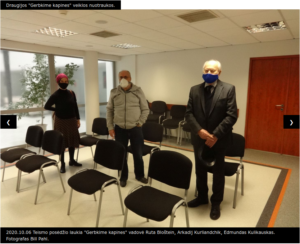
and in attendance at a recent hearing in the ongoing court case initiated by Dov-Ber and Chaya Fried and featuring over 100 affidavits from descendants around the world of people buried at Piramont Cemetery in Vilnius…
◊
Our victory is a miracle
If a band of eleven common thieves broke into Turto Bankas and stole 64 million euros, then it would be the Heist of the Century. All the more so if they gave it all away to the victims of the pandemic. Imagine a crowd of a hundred people throwing rocks into the sky and bringing down a couple of Apache fighter helicopters and seizing their controls. Stand by the gleaming seven-story Mariott Courtyard Hotel, view all the buildings around it, and realize that we have gutted the logic of this 21st century neighborhood.
The heavens can thunder all they want, the bull named Baal will scoff. But if eleven girls and boys surround the bull, and one wraps an iron chain around its neck, and another plants one end to the ground with an iron stake, then surely the lightning will strike hard. Which is to say, we can engineer miracles.
Our victory has a great purpose, which is to overcome the calamity of the Holocaust in Lithuania, to revive the virtues of the Grand Duchy, to embrace the Litvak love of Lithuania, to have a national symbol of Lithuania’s love of the Litvak people, to have a holy site that sings of the Jerusalem of Lithuania, to welcome the Creator to this biblical land.
Our victory, provisional as it may be, is a sign that this Year of the Vilna Gaon and of the History of the Jews of Lithuania (2020), was, in the end, named honorably. And if I may divert the attention of the editor to some other place on this page, then I will ask, in this Year, who recognizes our Litvak? The Algemeiner and the Prime Minister have answered.
◊
What happens next?
What happens next will depend on our loose alliance which consists of our small local group Respect Cemeteries (Gerbkime Kapines) led by Ruta Bloshtein, the Defending History community led by editor Dovid Katz, the international coalition led by Rabbi Elchonon Baron, and the intense personal efforts of Dov and Chaya Fried. If we do nothing, then the City of Vilnius and Turto Bankas will surely proceed with their 3 million euro agreement to cosmetically improve the territory around the Sports Palace, which is to say, our city’s Old Jewish Cemetery. And surely they will work with the official state-sponsored Lithuanian Jewish Community and even the London-based “Committee for the Preservation of Jewish Cemeteries in Europe” to implement a supposedly “acceptable solution”. Surely they will find some new excuse to restore and renovate the Sports Palace.
In Lithuanian history, Vytautas the Great won our greatest battle, Žalgiris (Grunwald), which brought to an end the Teutonic Knights’ two-hundred-year long Crusade against Lithuania. But he didn’t follow up by marching on Ordensburg Marienburg, their great castle. We are at a similar crossroads today. Yes, we believed in the Almighty, we hoped in Lithuanian democracy, we stood alongside Ruta Bloshtein, Dovid Katz, Julius Norwilla, Rabbi Elchonon Baron, Dov and Chaya Fried, and we won a storied victory against all odds, which reveals that the independent Republic of Lithuania of 2020 is not the Soviet-occupied Lithuania of 1965.
Do we disband or do we march on? I feel no joy in our victory for we ought to go on.
◊
Who claimed this was impossible?
Lithuania’s new Government has now turned away from the policy which previous administrations had followed since 2008. Those governments avoided all true Jewish believers, instead working privately with the official “Lithuanian Jewish Community,” whose leaders confirmed that they need not be believers, religious practitioners and were certainly no experts, and therefore could bring in the needed self-proclaimed experts, the Committee for the Preservation of Jewish Cemeteries in Europe (CPJCE), who could make all things look right and holy with their hasidic costumes. My own understanding is that Lithuanian Jewish Community leader Faina Kukliansky applied the same logic which Vilna Ghetto leader Jacob Gens did during the Holocaust. He would negotiate with the Nazis to give them fewer Jews to kill than they requested. Similarly, the Lithuanian Jewish Community haggled, we will give you this Cemetery, but you will help us care for other cemeteries, say in Balbieriškis (Yiddish: Balbírishok) or Molėtai (Malat). Their underlying logic was that “it is impossible to do anything about this”. As a Lithuanian I dare say, all the local Jews who depended on the status quo, all the ones who just said lay low, all the academics and intellectuals and organizers, all the youth and all the elderly, all the men on the dole who pray at the synagogue, all who received funding from the Good Will Fund, went along, and made our struggle so daunting. Thank heavens for the spiritual resisters whose role in history will not be forgotten. They include the Vilnius Jewish Community’s Simonas Gurevičius, Milan Chersonski, and Prof. Josifas Parasonis, as well as the foreign born rabbis who have served here, including Rabbi Sholem Ber Krinsky and Rabbi Shmuel Jacob Feffer. Surely there is a special place in history for Rabbi Chaim Burshtein, official chief rabbi at the time of the 2015 “new agreement” with the London-based CPJCE, who just did the right thing and came out with a powerful statement¸based on the views of a dozen major Litvak rabbis who had issued an edict against the shocking desecration. Rabbi Burshtein was promptly fired for his views. By contrast, Israeli Prime Minister Benjamin Netanyahu sadly went along.
So many powerful forces went against the Almighty. The Almighty gave a miraculous victory during Hanukkah to those who believed it was not impossible for Lithuania to forego the Congress Center and respect the Cemetery. Nobody foresaw that we could win this Hanukkah victory, just as nobody imagined how Soviet-occupied Lithuania could be free in our lifetimes.
Notably, the Lithuanian Government changed course, and stood against the Lithuanian Jewish Community and its aggressive defense (2015, 2016, 2017, 2019, 2019, 2020) of Turto Bankas and their business plans, and stood instead with Ruta Bloshtein and Dovid Katz, a handful of Lithuanian and Litvak dissidents, atheists, Catholics and orthodox believers, with the Bnei Brak rabbinical court, with the leaders of the Litvak yeshivas, with tens of thousands of Litvak descendants dispersed around the world. Indeed, the Lithuanian Government wrote to us, the local group, Respect Cemeteries (Gerbkime Kapines), numbering but eleven Lithuanians and Litvaks. The Lithuanian Government responded to us, local citizens, but yielded not to international pressure, however important that will ever be. Our strategy prevailed: to work together as Litvaks and Lithuanians locally, to cherish those local Jews who truly believe, to meet at our Cemetery every month, to read the Psalms of David, to pray to the Almighty, to resolve to persist for ten years or more, to write articles explaining our campaign in our local nationalist press, to engage our society and our government on all levels, to work openly, inclusively, never falsely or anonymously, through regular and proper channels, heartfully, uncompromisingly, to speak up for ourselves, to do what we can without money, to seize on the productive moment, and only then to mobilize help from all around the world.
◊
What is our vision now?
We have the opportunity in this coming year to develop and pursue our vision of the Cemetery. In that spirit, I dare imagine that, first of all, we should be guided by the regular local religious traditions that we develop on site, taking the lead from Jewish believers, inviting all to join, and welcoming pilgrims from afar. We need Litvak believers around the world to contribute their visions, concerns, hopes and dreams to our local believers and nurture us here so that we engage others together. Second, we should insist that the City promptly fence off the Cemetery so that there is but one main entrance, at the Northwest Corner, and that people are discouraged from cutting through, and start respecting it as a Cemetery. Further, we should insist that the City rework entirely its plans for the surroundings with input from us and others, and as Rabbi Elchonon Baron has mentioned, observing all the religious but also cultural and aesthetic details befitting the Vilnius Jewish Cemetery, so that there is no irrigation, no cultivation of plants, no mechanical mowing of the lawn. We should aspire to recreate the Cemetery gate and perhaps collect donations for that from around the world. We should urge the City to focus on developing the outside of a kilometer long wall as an artistic touristic attraction expressing our City’s virtue. We should encourage an appreciation for the people of the Jerusalem of Lithuania, the residents of the Cemetery, the stories of their lives and the images of their tombs, and a sense of the centuries which link us and them, the Grand Duchy and the new Republic. We should see that the Sports Palace can be meaningful as an imperial Soviet ruin, as impressive as any Roman ruin, gradually collapsing over time, watchfully disassembled with rabbinical supervision, respecting the peace of those who rest, for as long as it can ever take, a symbolic reminder of the history of those who willed to desecrate and those who later willed yet again, those who rest in peace and those who love them.
How can this site be made holy by the unclean, those who completely discredited themselves?
We are called to be holy, to learn to love this Cemetery, to claim the Almighty’s victory of this day.
